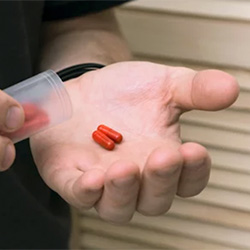By Marie Rosenthal, MS
In a 13-10 vote, the FDA’s Antimicrobial Drugs Advisory Committee (AMDAC) voted that the risks versus the benefits of the prodrug molnupiravir to prevent hospitalization and death in people with mild to moderate COVID-19 favored an emergency use authorization (EUA).

However, there was much concern about the theoretical possibility of escape mutants, as well as potential bone and fetal toxicities seen in animal studies, which led to the close vote. In addition, there were repeated calls for more data and for protections for pregnant women.
“I voted no, likely coming from the clinical pharmacologist inside of me,” said Jennifer Le, PharmD, MAS, FIDSA, FCCP, FCSHP, BCPS-ID, a clinical pharmacist at the Skaggs School of Pharmacy and Pharmaceutical Sciences at the University of California, San Diego. “I appreciated that pharmacologic safety is generally more evident in post-marketing surveillance; yet, the pre-marketing studies that we've seen here demonstrate highly relevant signals for safety concerns,” she said. That, coupled with the “modest benefit,” led to her vote.
Molnupiravir, being developed by Merck and Ridgeback Biotherapeutics, is an oral ribonucleoside analog that causes viral mutations within SARS-CoV-2, which impede its ability to replicate and spread, according to Daria J. Hazuda, PhD, the vice president of Infectious Disease and Vaccines, at Merck.
Delta, gamma and mu variants accounted for the vast majority of the baseline viral variants that had been sequenced at the time of the interim analysis. Dr. Hazuda said by targeting replication instead of the spike protein, molnupiravir is more likely to be effective against all variants, and the company added that it is continuing to study the drug’s effects against the new variant of concern, omicron. Molnupiravir resulted in a rapid decline of viral load, decreasing the likelihood of transmitting variants.
However, many panel members were concerned that these mutation errors could lead to less efficacious vaccines and treatments.
“Even if the probability is very low,” James K. Hildreth Sr., MD, PhD, the president and CEO of Meharry Medical College, in Nashville, who also voted against the recommendation, called the possibility that “this drug would induce an escape mutant” against which vaccines would not work “catastrophic for the whole world.”
Another concern was fetal toxicities in rats that could be lethal or cause bone plate growth disorders. These findings are not relevant in the adult human skeleton. Merck said molnupiravir should not be given to children or pregnant women or women who might become pregnant, and the FDA reviewers concurred with this assessment and said they are developing a risk mitigation strategy to ensure that does not occur.
However, Aimee Hodowanec, MD, the senior medical officer in the FDA Division of Antivirals, called the risk for “mutagenicity” low.
“I felt that the overall absolute effect in the total trial population was modest at best,” said Sankar Swaminathan, MD, who voted against the recommendation. “The risk of mutagenic effects on the patient is not firmly established or characterized, and given the large potential population affected, the risk of widespread effects on potential birth defects—especially delayed effects on the male—has not been adequately studied,” explained Dr. Swaminathan, the chief of infectious diseases at the University of Utah School of Medicine, in Salt Lake City.
In addition to safety data, the committee considered data from the phase 3 MOVe-OUT trial (ClinicalTrials.gov Identifier: NCT04575597), a global, randomized, double-blind, placebo-controlled study. The trial enrolled nonhospitalized adults with mild to moderate COVID-19, who had at least one risk factor that was associated with poor outcomes. Molnupiravir reduced the risk for hospitalization or death among high-risk unvaccinated adults by 30% through day 29, but the drug needs to be given within five days of onset of symptoms.
Nine of the 10 participants who died through day 29 were in the placebo group. The proposed oral treatment regimen would be twice a day for five days.
The most common risk factors for poor disease outcome included obesity, age older than 60 years, and having diabetes mellitus and heart disease.
Molnupiravir is being studied as a single medicine that can be given without food intake restrictions or dose modifications based on renal or hepatic impairment, Merck said.
“I agree with all that's been said by both the yes and no voters,” said AMDAC Chair Lindsey R. Baden, MD. “I see this as an incredibly difficult decision, and it's already been stated there are many, many more questions than answers. However, as I see the regulatory framework: Are there circumstances where the benefit may exceed the risk? And I think the mortality data I found compelling,” he said.
However, Dr. Baden said the study result “speaks to the right patient population, the right virus at the right time. But for me, that at least suggests that there are populations where there may be benefit—then puts a burden on the agency and on the applicant and on the community to continue to vigorously study so that we can better define who's likely to benefit.”
Currently, there are three monoclonal antibody regimens that are administered intravenously or subcutaneously, with an EUA for mild to moderate COVID-19 in adults and children 12 years of age and older, who are at risk for progressing to severe disease, including hospitalization and death. They can be given within 10 days of the development of symptoms.
There is no approved oral treatment for this patient population.
The FDA is not bound by the committee’s guidance but takes its advice into consideration.
In anticipation of regulatory authorization, Merck has been producing molnupiravir at risk and expects to produce 10 million courses of treatment by the end of 2021, with at least 20 million courses to be produced in 2022. Merck entered into a procurement agreement with the U.S. government under which the company will supply approximately 3.1 million courses of molnupiravir to the United States. In addition, the company entered into a licensing agreement with the Medicines Patent Pool to increase broad access to molnupiravir by low- and middle-income countries.
{RELATED-HORIZONTAL}